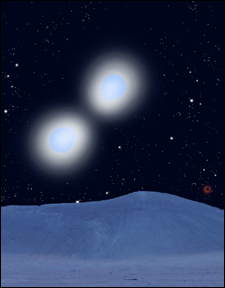Harvard scientists describe heaviest stars
Fiery giants 80 times mass of sun
Harvard astronomers determined last month that a pair of celestial titanic twins

are the heaviest stars ever measured by scientists, with each one tipping the scales at 80 times the mass of Earth’s sun.
The stars are in an unusual binary configuration in which the two twirl around a common center. The stars are even more unusual in that they are roughly the same size, unlike most binary star systems. The stars are of the rare Wolf-Rayet type, which are noted for their short lives.
The work was conducted by Alceste Bonanos, a doctoral student and research assistant in astronomy, and Assistant Professor of Astronomy Krzysztof Stanek. The two, with colleagues from the Warsaw University Observatory in Chile, built on recent work by Belgian astronomers who identified the system as having particularly massive stars. The Belgian team couldn’t determine the stars’ mass exactly, but were able to say they had a minimum of 70 times the mass of the sun.
“It immediately got my attention because I had never heard of stars that were that massive,” Bonanos said.
The stars, called WR 20a, are about 20,000 light years from Earth, located in the southern hemisphere’s constellation Carina. The stars are twirling around each other fast and close. They’re separated by less than five times the diameter of Earth’s sun and moving at about 200 miles per second. At that speed, they orbit each other every 3.7 days.
“It’s hard to imagine what it must be like for them to be flying around so near to each other,” Bonanos said.
The stars are by far the most massive ever accurately measured. The previous champions were in another binary system, at between 50 and 60 times the mass of the sun. Though the stars are the most massive ever measured, astronomers suspect there are heavier stars out there, such as the Pistol Star and eta Carinae, which are thought to be more than 100 times the mass of the sun, but which have never been accurately measured.
The discovery comes after quick work by Bonanos and Stanek to fill in the blanks left by the Belgian team, which reported its results in late April. Bonanos had a lot of experience working with binary stars, as her research uses binary stars in distant galaxies as tools to determine how far away the galaxies are. Stanek’s work on gamma ray bursts, a fleeting cosmic phenomenon that requires quick responses when one is detected, also stood him in good stead.
More than two weeks of clear weather near the observatory in Chile didn’t hurt either, Stanek said.
Stanek contacted former colleagues at the Warsaw University Observatory, who were able to help. The observatory’s Optical Gravitational Lensing Experiment (OGLE) team, led by Andrzej Udalski, took measurements of WR 20a using their 1.3 meter OGLE telescope at the Las Campanas Observatory in Chile. Aided by clear weather, they observed a series of eclipses in the system, in which the stars passed in front of each other.
Using measurements from the eclipses, Bonanos and Stanek were able to determine both the time it takes for the two stars to orbit each other and the angle at which they were viewing the system. From those two measurements, Bonanos and Stanek were able to determine the mass of the system’s two stars.
“We got very excited. We got lucky in Chile, with 17 clear nights in a row,” Stanek said.
The stars will help shed light on the universe’s largest stars and also help astronomers understand various phenomena in the universe, including supernovas, gamma ray bursts, and the formation of stars early in the universe’s life, when stars were thought to be particularly massive.
“It becomes a lab for testing stellar evolution and star formation models,” Stanek said.




